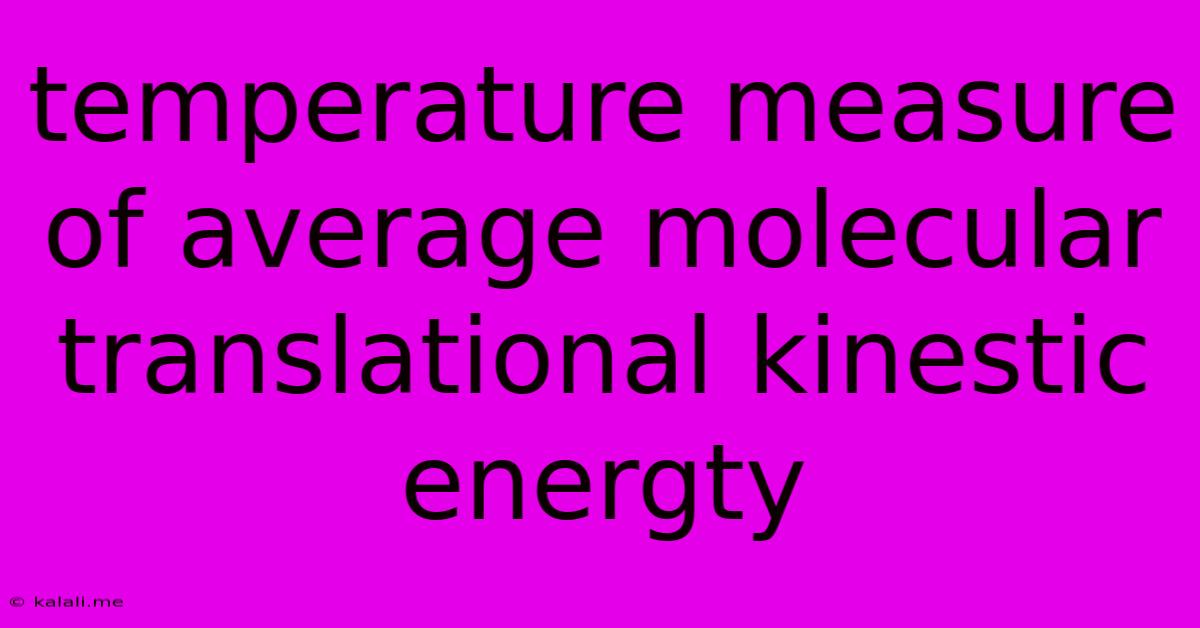Temperature Measure Of Average Molecular Translational Kinestic Energty
Kalali
Jun 04, 2025 · 3 min read

Table of Contents
Measuring Temperature: A Reflection of Average Molecular Translational Kinetic Energy
Temperature, a seemingly simple concept, is fundamentally a measure of the average translational kinetic energy of the molecules within a substance. Understanding this connection is key to grasping the nature of heat and its interactions with matter. This article delves into the relationship between temperature and molecular kinetic energy, exploring how we measure temperature and the implications of this connection in various fields.
What is Translational Kinetic Energy?
Before we delve into measuring temperature, let's clarify what we mean by translational kinetic energy. Unlike rotational or vibrational kinetic energy, which involves spinning or internal vibrations, translational kinetic energy refers to the movement of a molecule from one point to another. It's the energy associated with the linear motion of molecules. The faster the molecules move, the higher their translational kinetic energy.
The Link Between Temperature and Kinetic Energy
Temperature is directly proportional to the average translational kinetic energy of the molecules. This means that a higher temperature signifies a higher average kinetic energy, and vice-versa. It's crucial to note the word "average" here. Individual molecules within a substance possess a range of kinetic energies due to constant collisions and interactions. Temperature represents the average of these energies. This relationship holds true for ideal gases and provides a reasonable approximation for many other substances.
Measuring Temperature: Various Methods
Several methods exist for measuring temperature, each exploiting the effects of temperature changes on physical properties:
-
Thermometers based on thermal expansion: These are the most common type, utilizing the principle that most materials expand when heated. Mercury or alcohol thermometers rely on the expansion of the liquid within a sealed glass tube. The change in liquid volume directly correlates to the temperature. Bimetallic strip thermometers utilize the different thermal expansion rates of two bonded metals to create a bending motion that indicates temperature.
-
Resistance Thermometry: The electrical resistance of certain materials, like platinum, changes predictably with temperature. Resistance temperature detectors (RTDs) exploit this property for accurate temperature measurement, particularly in precise scientific applications.
-
Thermocouples: These devices utilize the Seebeck effect, where a voltage difference is generated between two dissimilar metals when a temperature difference exists between their junctions. Thermocouples are rugged and versatile, enabling temperature measurement across a wide range.
-
Infrared Thermometry: Infrared thermometers measure the infrared radiation emitted by an object. Since the intensity of this radiation is related to the object's temperature, this technique allows for non-contact temperature measurement.
Applications of Understanding this Relationship
The understanding of the relationship between temperature and molecular kinetic energy is fundamental to many scientific and engineering disciplines:
-
Chemistry: Reaction rates are heavily influenced by temperature, as higher temperatures lead to increased molecular collisions and higher activation energies.
-
Physics: The study of thermodynamics heavily relies on the concept of temperature and its relation to energy transfer.
-
Material Science: The properties of materials, like strength and conductivity, are significantly affected by temperature.
-
Meteorology: Accurate temperature measurement is crucial for weather forecasting and climate monitoring.
Conclusion
Temperature is not just a number; it's a direct reflection of the average kinetic energy of molecules within a substance. Understanding this relationship is vital in diverse fields. The various methods used to measure temperature all ultimately boil down to observing the effects of this kinetic energy on the physical properties of materials, highlighting the fundamental importance of this connection in our understanding of the physical world.
Latest Posts
Latest Posts
-
How Long Is Canned Tuna Good For
Jun 06, 2025
-
Wire Three 12v Batteries In Parallel
Jun 06, 2025
-
The Upper Room In The Bible
Jun 06, 2025
-
When Did Jesus Fast For 40 Days
Jun 06, 2025
-
What Is Stochastic Systems In Electrical Engineering
Jun 06, 2025
Related Post
Thank you for visiting our website which covers about Temperature Measure Of Average Molecular Translational Kinestic Energty . We hope the information provided has been useful to you. Feel free to contact us if you have any questions or need further assistance. See you next time and don't miss to bookmark.